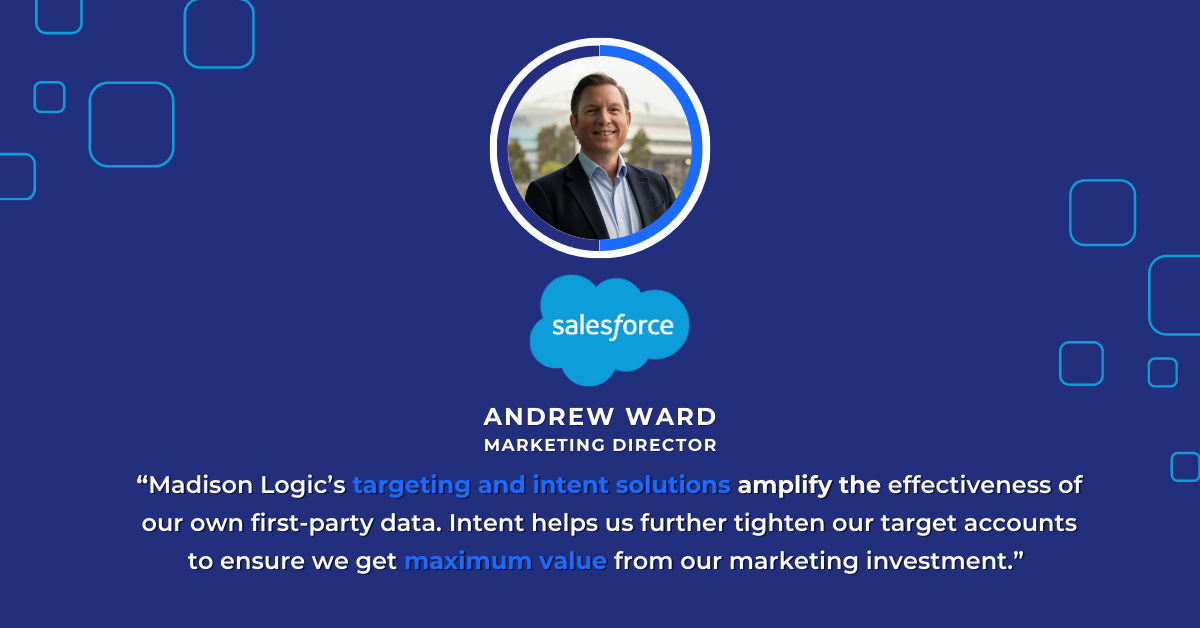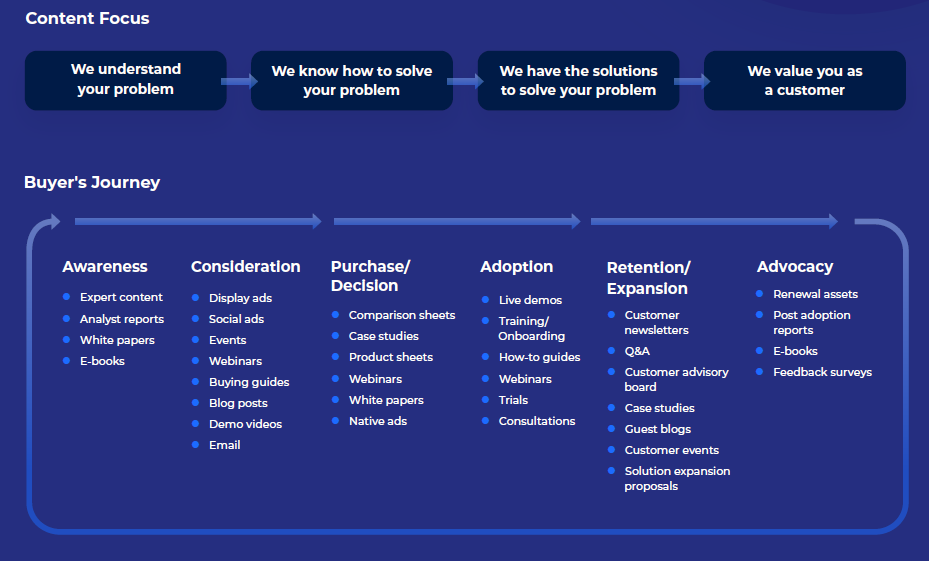
3 Practices You Should Follow to Build Killer Content for Your ABM Strategy

Content marketing is the way we speak to our customers about our brand and our solutions. But it’s more than just repeating our value proposition in various ways; it’s about connecting with the customer and getting them to trust us.
Why? Because buyers, not sellers, have all the power in B2B. While they appreciate our clever wordsmithing and attractive graphics, these mean nothing if we’re not giving them the experience they want in the buyer’s journey. They expect us to understand who they are, what they need, and when they need it. This is the foundation of a personalized customer experience.
Here are three practices you should follow when building better content and personalizing the experience for your next ABM campaign.
1. Build content for your audience using data, not intuition
Research from Gartner shows that meaningful personalization boosts the chances that a customer will make a high-quality purchase by 9%. But delivering a personalized customer experience requires you to fully understand your audience and what influences them to choose you as their solution provider. You may think you know what buying groups are looking for and what they care about, but here are some trends to pay attention to:
- A younger buying committee: B2B Buying committees have become bigger, more diverse, and younger, with more Millennials and Gen Zers than ever before. These younger, digital-first buyers demand experiences that mirror their B2C journeys. They need brands to know who they are, what they care about, and what their expectations are.
- A more independent process: Most of the time spent by a B2B buying committee is away from solution providers. Gartner finds that only 17% of buying groups’ time is dedicated to meeting with potential providers. Marketers need to know what these buyers are looking for when they’re ready to talk to help their sales teams.
Considering that up to 90% of the buying journey is complete before a prospect engages with a sales team, you need data to identify not only the accounts actively in-market but the people within these trending accounts who are researching and engaging with relevant content and messaging. Otherwise, the content won’t be personalized to the audience, and you can’t deliver a great customer experience that helps close out those high-value deals we all want.
Use data that signal purchase intent to identify and understand your audience. Data like ML Insights can tell you:
- What they’re searching for
- How they engaged with similar campaigns
- What technology they use
Combined, these insights can be a powerful signal into what your best accounts are, which buying committee members you should engage with, and how they’re being targeted across multiple digital channels. Use this signal to weigh your assumed target accounts list and filter out the best-fit accounts that you can speak to when thinking about content.
Once you identify your best accounts, it’s important to take a closer look at the individuals on the buying committee and ask:
- Who are they?
- What’s their role in the organization?
- Where are they in the buying journey?
- What are they trying to accomplish?
- What pain points and challenges are they facing?
Supplement these insights with first-party data from your CRM and marketing automation solution to understand what content they need to progress. Look at won deals and existing accounts in the pipeline to understand what content resonates with them the most, and at which stage of the buying journey.
You should also engage with team members at your organization to better understand your target audiences. For example, your sales teams have daily conversations with current and prospective accounts. They can be a resource to help you identify who you can target for higher ROI and pipeline impact. In the later stages of the sales cycle, they see how your content and messaging affect purchase decisions first-hand. Your customer success teams are excellent resources to understand what you can do better to create an exceptional customer experience. They are the first source customers go to with questions and concerns, and they’re there to help your customers achieve their goals and objectives with your solution.
Identifying your target accounts and understanding who they are through data and insights are extremely helpful when building content for a personalized customer experience.
See it in action:
Salesforce is the global leader in customer relationship management software and applications focused on sales, customer service, marketing automation, analytics, and application development. Andrew Ward, Marketing Director for Salesforce Australia and New Zealand, and his team needed help in personalizing content campaigns that target each customer at each step of the buying journey.
“In a world where personalization and relevance are hyper-important, we need to deliver value to individuals within these accounts.”
They partnered with Madison Logic to identify key decision-makers on buying committees and their buying behavior. By combining Salesforce’s first-party account data with the ML Insights combined data set, we helped Andrew and his team identify decision-makers and champions involved in purchase decisions for each account.

2. Map out content to the buyer’s journey based on what they need and what they want
Buyers desire specific content according to their needs and goals. Marketers need to adapt their content strategies to give them what they want and positively affect the buyer’s experience.
In our ABM Success Series virtual event, guest speaker Nora Conklin, Principal Analyst at Forrester Research, shared the findings from Forrester’s 2021 Content Preferences Survey which reveals that nearly 90% of tech decision-makers say that it’s important for tech vendors to provide relevant content at each stage of the buying process. And as technology buyers progress through their purchase journeys, marketers must understand that their content format and length preferences change. For example:
- In the early stage of learning about a solution, buyers require bite-sized information that will not overwhelm them or assume that they know more than they do, short-form content performs best here.
- In short-listing vendors, buyers find short-form video and long-form written content helpful because they require a bit more information in understanding how a solution works to solve a problem.
- In choosing one vendor, buyers need more in-depth information via long-form content because they need to accurately understand the differences and benefits of choosing one vendor over the other.
- In the post-sales relationship, interactive tools bring more utility from a buyer’s investment in a solution to give them more value.
These findings tell us that interactive tools and video stand out as preferred content forms, but the length and nature of these forms change throughout different parts of the buyer’s journey. B2B marketers need to marry their content to audiences’ expectations and build a variety of content options for each stage in varying lengths and formats.
Here’s a quick guide from the 2023 Full-Funnel ABM Playbook to help you understand how to map content to personalize and own the customer experience:

3. Measure your content’s impact on the sales pipeline to know if you’re delivering a great experience
In a perfect world, all personalized content instantly converts your best accounts. Unfortunately, that isn’t always the case. When thinking about content, you need to measure its impact on the sales pipeline to truly understand its effect. Accurate measurement and reporting are core components of any successful ABM strategy and will help you test and improve the customer experience.
An effective way to measure and demonstrate the impact of your ABM campaign and your content is through the lens of the 3 Vs:
Volume – The number of leads AND opportunities in your pipeline.
Value – How much you’re getting back from the accounts you’re targeting with your ABM campaigns.
Velocity – The average time an account converts from a lead to an opportunity to a customer.
Volume can tell you how effective your content is. The higher the number of leads and opportunities in your sales pipeline, the more successful your content strategy is. It reveals that these accounts are taking notice and you’re initiating conversations with your content. If your pipeline numbers are low, you may need to rethink your audience and what they need from your content.
Value reveals how well you’re communicating your brand’s value to the account through your content. If you’re seeing large numbers in your pipeline value, they like what they see and that’s a hint to build upon that content strategy to continue increasing deal sizes.
Velocity shows you how accounts move through the sales cycle, so you can customize your account nurturing, segmentation, and content strategy to accelerate these key accounts faster. Remember, content should be the right message, delivered to the right person, at the right time.
The right metrics can give you unparalleled insights into content and messaging performance, allowing you to make strategic decisions based on what is and isn’t working.
Personalize the experience with better content practices
For great ABM, you need to create a content strategy that not only speaks to your brand’s value proposition but also connects the audience to your brand through personalized customer experiences. You must rely on more than just your intuition and:
- Use data to understand your audience
- Map out your content to match the buyer’s journey and what they like
- Measure the impact of your content strategy on your sales pipeline to gauge its effectiveness
By following these three practices to build a more personalized customer experience with your content, you can tell a better story that’s meaningful, impactful, and establishes trust with your customers.

